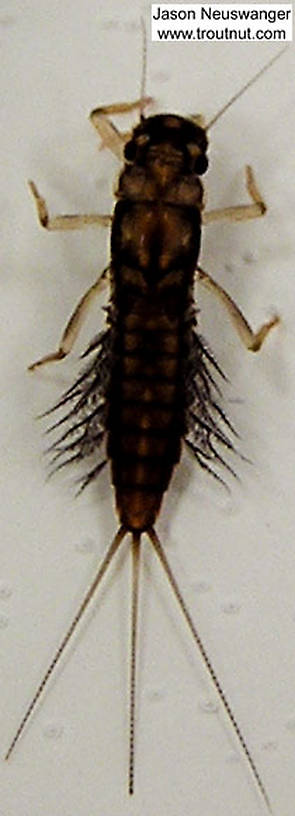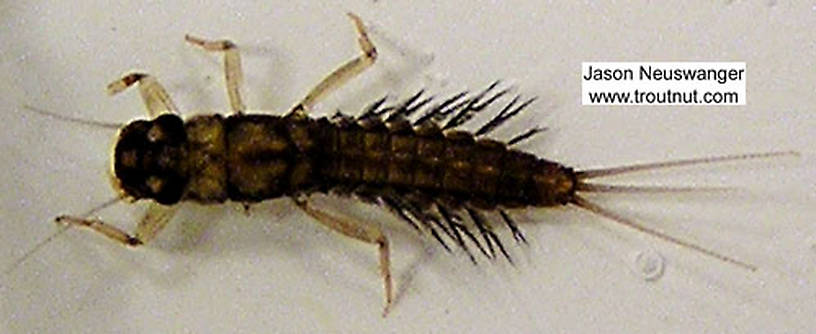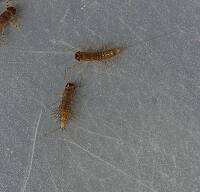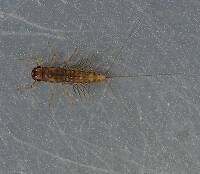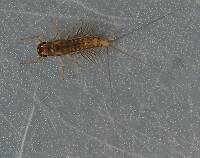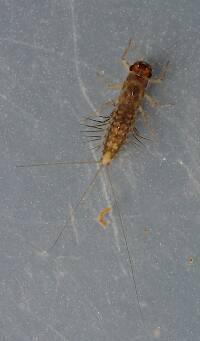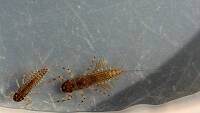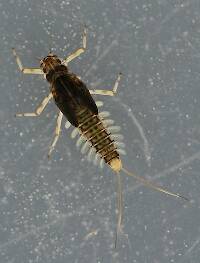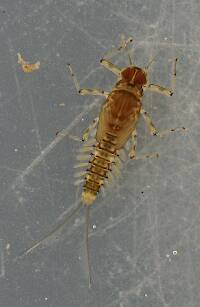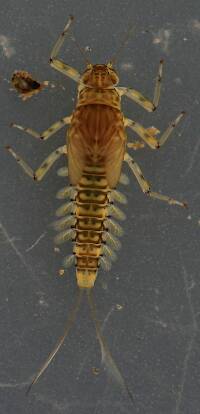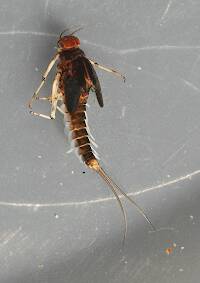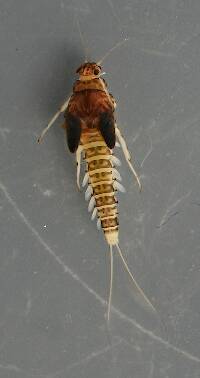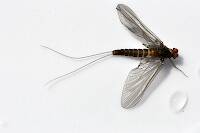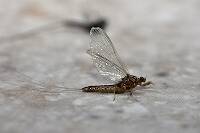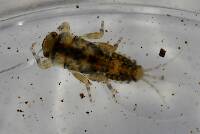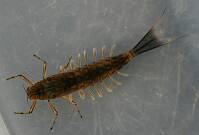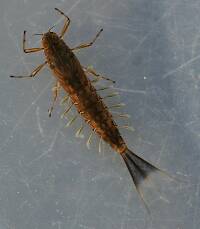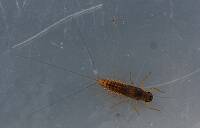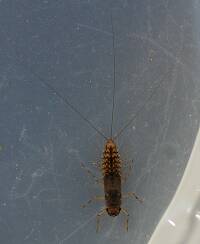
Salmonflies
Pteronarcys californica
The giant Salmonflies of the Western mountains are legendary for their proclivity to elicit consistent dry-fly action and ferocious strikes.
Featured on the forum
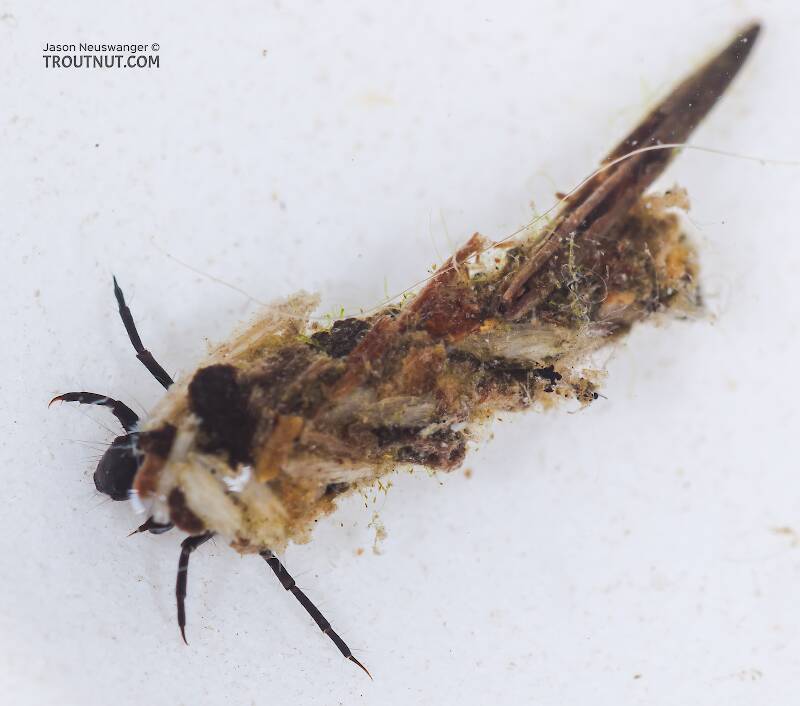
This seems to be a young larva of Limnephilus. Although not clear in the picture, several ventral abdominal segments have chloride epithelia.

Troutnut is a project started in 2003 by salmonid ecologist Jason "Troutnut" Neuswanger to help anglers and
fly tyers unabashedly embrace the entomological side of the sport. Learn more about Troutnut or
support the project for an enhanced experience here.
This topic is about the Mayfly Genus Paraleptophlebia
There are many species in this genus of mayflies, and some of them produce excellent hatches. Commonly known as Blue Quills or Mahogany Duns, they include some of the first mayflies to hatch in the Spring and some of the last to finish in the Fall.In the East and Midwest, their small size (16 to 20, but mostly 18's) makes them difficult to match with old techniques. In the 1950s Ernest Schwiebert wrote in Matching the Hatch:
"The Paraleptophlebia hatches are the seasonal Waterloo of most anglers, for without fine tippets and tiny flies an empty basket is assured."
Fortunately, modern anglers with experience fishing hatches of tiny Baetis and Tricorythodes mayflies (and access to space-age tippet materials) are better prepared for eastern Paraleptophlebia. It's hard to make sense of so many species, but only one is very important and others can be considered in groups because they often hatch together:
- Paraleptophlebia adoptiva is by far the most important species of this genus in the two regions and is an early Spring emerger.
- Paraleptophlebia mollis, Paraleptophlebia guttata, and Paraleptophlebia strigula complement each other in late spring and early summer.
- Paraleptophlebia debilis and Paraleptophlebia praepedita occur together in the fall.
- The most important species is Paraleptophlebia debilis. This large (for the genus) Fall emerger can be found throughout the region. It is often accompanied by one of the slightly larger tusked species. Depending on locale, this can be Paraleptophlebia bicornuta (the most common), Paraleptophlebia packii or Paraleptophlebia helena. Check out their hatch pages for distribution information.
- Spring is the season for the smaller Paraleptophlebia heteronea throughout most of the region with Paraleptophlebia gregalis filling this niche in California and parts of Oregon.
Example specimens
Entoman on Feb 4, 2012February 4th, 2012, 10:50 am EST
Paul wrote in another topic:
I largely agree, though they seem to be more tolerant of current than most genera of leptophlebiids. I have sampled them from riffles. In my experience (with an admitted western bias), they are far more important in the Fall. If an angler is lucky enough to be in place (and aware of them) when they are schooled up in preparation for hatching, some memorable nymphing can take place! :)
P. adoptiva is an eastern species. By far the most important species in the West is P. debilis, though they can be found mixed with others, particularly the unusual tusk bearing species bicornuta and in some locales packii. Anglers that occasionally come across these tuskers often confuse them with the immature burrowing ephemerids they resemble. Many anglers use their standard nymphs and do just fine with them. The PT is a popular pattern. Sometimes, a nymph that more accurately suggests their silhouette is the ticket. Because of their build and very obvious gills, they look more like a small long-tailed burrower than they do the typical baetid or ephemerellid, and it is good for the angler to keep this in mind.
Most duns and spinners are typically a rich brown, hence the name "Mahogany Dun." They can run the gamut from gray to almost black though, depending on the location. The slender bodies and coloration of the duns lead to them often being mistaken for baetids, but the oval vertically held hind wings and three tails make them easy to distinguish from that family. Check out this link to the hatch page for a look at the natural dun.
http://www.troutnut.com/hatch/752/Mayfly-Paraleptophlebia-debilis-Mahogany-Dun
Below are a couple of patterns I find very useful when this critter is about.
Mahogany Dun Nymph #16

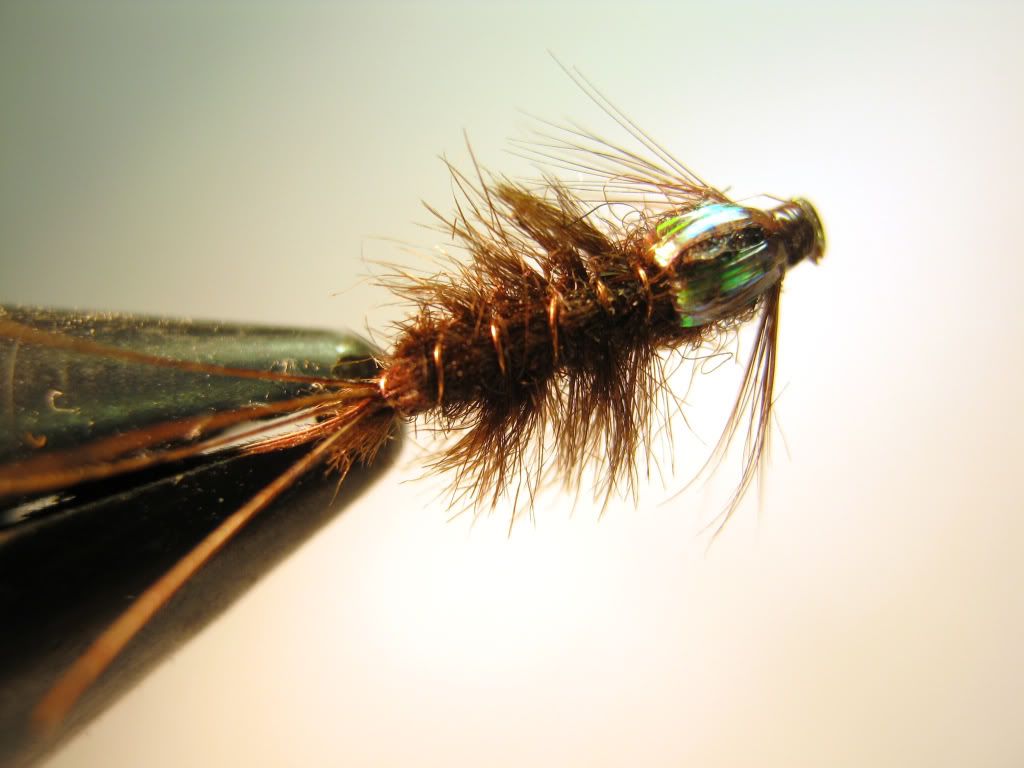
Mahogany Paradun #16

Yes, the Paraleps can come about the same time as the tricaudatus, but don't start as early I think. And I think they were a mid-morning deal where tricaudatus has more of an afternoon peak. (Here in the rockies we're not supoosed to don't have the early P adoptiva, although last spring I found a single youngish nymph that my key would only take it to adoptiva -by gills if I remember right. Wish I'd pickled it and had it properly ID'd.
Anyway, back east I found the Paraleps emerged from slower currents and siltier substrates -often along stream edges. Whereas tricaudatus spilled out of the riffles. They could mix of course in certain places, but one could find one predominant if you wanted to (and I did bc I wanted to know each better), by focusing on key habitat.
Fly patterns could be identical really, although I had my own, esp for the nymphs. In fact, I'm still using some P adoptiva mimic parachutes (more a dun gray) during Baetis activity.
I largely agree, though they seem to be more tolerant of current than most genera of leptophlebiids. I have sampled them from riffles. In my experience (with an admitted western bias), they are far more important in the Fall. If an angler is lucky enough to be in place (and aware of them) when they are schooled up in preparation for hatching, some memorable nymphing can take place! :)
P. adoptiva is an eastern species. By far the most important species in the West is P. debilis, though they can be found mixed with others, particularly the unusual tusk bearing species bicornuta and in some locales packii. Anglers that occasionally come across these tuskers often confuse them with the immature burrowing ephemerids they resemble. Many anglers use their standard nymphs and do just fine with them. The PT is a popular pattern. Sometimes, a nymph that more accurately suggests their silhouette is the ticket. Because of their build and very obvious gills, they look more like a small long-tailed burrower than they do the typical baetid or ephemerellid, and it is good for the angler to keep this in mind.
Most duns and spinners are typically a rich brown, hence the name "Mahogany Dun." They can run the gamut from gray to almost black though, depending on the location. The slender bodies and coloration of the duns lead to them often being mistaken for baetids, but the oval vertically held hind wings and three tails make them easy to distinguish from that family. Check out this link to the hatch page for a look at the natural dun.
http://www.troutnut.com/hatch/752/Mayfly-Paraleptophlebia-debilis-Mahogany-Dun
Below are a couple of patterns I find very useful when this critter is about.
Mahogany Dun Nymph #16


Mahogany Paradun #16

"It's not that I find fishing so important, it's just that I find all other endeavors of Man equally unimportant... And not nearly as much fun!" Robert Traver, Anatomy of a Fisherman
PaulRoberts on Feb 4, 2012February 4th, 2012, 11:01 am EST
Ah...I had edited out my last statement in the other thread: That adoptiva duns are pale grayish (although this will often suffice, and for tricaudatus). My gray dun patterns were for the later P mollis -which I believe I have some here in CO too.
I don't know debilis well, but have seen them. A fall emergence mostly I think. These exist in the east too, but I don't remember whether I keyed them. I did fish an autumn Paralep, but I seem to remember wondering whether some were 2nd brood mollis. I'd have to check back into my journals and see what I was thinking then.
Yes, P adoptiva is a deep rich mahogany, and they prefer slower currents. My dun pattern for these was a mahogany Comparadun. I did sample the nymphs in riffles (usually well tucked under substrate and esp in leaf packs. But I found lots more closer to shorelines with some silt, and believe at emergence time they migrate to the siltier shorelines to emerge -similar to what McCaffertum and Stenacron will do.
I don't know debilis well, but have seen them. A fall emergence mostly I think. These exist in the east too, but I don't remember whether I keyed them. I did fish an autumn Paralep, but I seem to remember wondering whether some were 2nd brood mollis. I'd have to check back into my journals and see what I was thinking then.
Yes, P adoptiva is a deep rich mahogany, and they prefer slower currents. My dun pattern for these was a mahogany Comparadun. I did sample the nymphs in riffles (usually well tucked under substrate and esp in leaf packs. But I found lots more closer to shorelines with some silt, and believe at emergence time they migrate to the siltier shorelines to emerge -similar to what McCaffertum and Stenacron will do.
Entoman on Feb 4, 2012February 4th, 2012, 11:14 am EST
Hi Paul -
Though there are currently 7 species reported in CO, odds are that you are probably dealing with debilis. Both adoptiva and mollis are eastern species and are unreported for your state to the best of my knowledge. As to color, they are often grayish in many locales. I haven't a clue why, perhaps environmental?
Regards,
Kurt
Though there are currently 7 species reported in CO, odds are that you are probably dealing with debilis. Both adoptiva and mollis are eastern species and are unreported for your state to the best of my knowledge. As to color, they are often grayish in many locales. I haven't a clue why, perhaps environmental?
Regards,
Kurt
"It's not that I find fishing so important, it's just that I find all other endeavors of Man equally unimportant... And not nearly as much fun!" Robert Traver, Anatomy of a Fisherman
Entoman on Feb 4, 2012February 4th, 2012, 11:18 am EST
...and believe at emergence time they migrate to the siltier shorelines to emerge -similar to what McCaffertum and Stenacron will do.
Yes and no. Heptageniids crawl to their staging sites. Leptophlebiids swim like a school of minnows (though there is some evidence to suggest this isn't always the case as they can hatch from where they reared if conditions are optimal).
"It's not that I find fishing so important, it's just that I find all other endeavors of Man equally unimportant... And not nearly as much fun!" Robert Traver, Anatomy of a Fisherman
PaulRoberts on Feb 4, 2012February 4th, 2012, 11:55 am EST
I've never seen a school of Paraleps, but water fertility might have prevented that (?). Although I've caught Leptophlebia, we never had them in numbers, although I believe I've read about them in large numbers along quiet shorelines.
I guess I'm under the impression that Paraleps (at least adoptiva) preferred/required quieter water to emerge from. I remember some strong mollis emergences from mod grade riffles.
MaCaffertium and Stenacron esp, I found in large numbers at emergence time in shoreline eddies alongside riffles.
I guess I'm under the impression that Paraleps (at least adoptiva) preferred/required quieter water to emerge from. I remember some strong mollis emergences from mod grade riffles.
MaCaffertium and Stenacron esp, I found in large numbers at emergence time in shoreline eddies alongside riffles.
Entoman on Feb 4, 2012February 4th, 2012, 12:13 pm EST
I've never seen a school of Paraleps, but water fertility might have prevented that (?)
Possibly... Where I've noticed the behavior is on spring creeks and smooth runs on larger rivers. Smaller freestones probably just see them migrating to the softer silt-filled margins or softer runs as you suggest.
I guess I'm under the impression that Paraleps (at least adoptiva) preferred/required quieter water to emerge from.
I agree, though they will emerge in runs if they aren't too swift.
MaCaffertium and Stenacron esp, I found in large numbers at emergence time in shoreline eddies alongside riffles.
Yes, though how they got there differs greatly from Paraleptophlebia.
"It's not that I find fishing so important, it's just that I find all other endeavors of Man equally unimportant... And not nearly as much fun!" Robert Traver, Anatomy of a Fisherman
Entoman on Feb 6, 2012February 6th, 2012, 1:27 am EST
Hi Paul -
BTW, that Spring Paraleptophlebia you found was undoubtedly heteronea. It's the important Spring one everywhere in the West but CA and parts of OR. Another thing I forgot to mention is that you probably run into a few tusked packii or bicornuta mixed in with the fall hatches of debilis. Excepting a slight difference in size, the duns can look pretty much identical in the hand.
Check out the recently revised Paraleptophlebia hatch page if you haven't done so in awhile. It's just been updated to clear up a lot of confusion regarding this genera, especially between East and West. I think you'll find the notes on spinner behavior especially interesting.
http://www.troutnut.com/hatch/47/Mayfly-Paraleptophlebia-Blue-Quills-&-Mahogany-Duns
The species pages accessible from there are worth a gander too. They have been updated as well with more pictures added for you to compare.
Regards,
Kurt
BTW, that Spring Paraleptophlebia you found was undoubtedly heteronea. It's the important Spring one everywhere in the West but CA and parts of OR. Another thing I forgot to mention is that you probably run into a few tusked packii or bicornuta mixed in with the fall hatches of debilis. Excepting a slight difference in size, the duns can look pretty much identical in the hand.
Check out the recently revised Paraleptophlebia hatch page if you haven't done so in awhile. It's just been updated to clear up a lot of confusion regarding this genera, especially between East and West. I think you'll find the notes on spinner behavior especially interesting.
http://www.troutnut.com/hatch/47/Mayfly-Paraleptophlebia-Blue-Quills-&-Mahogany-Duns
The species pages accessible from there are worth a gander too. They have been updated as well with more pictures added for you to compare.
Regards,
Kurt
"It's not that I find fishing so important, it's just that I find all other endeavors of Man equally unimportant... And not nearly as much fun!" Robert Traver, Anatomy of a Fisherman
PaulRoberts on Feb 6, 2012February 6th, 2012, 8:08 am EST
Thanks Kurt. Very helpful. I'm still getting familiar with many of our western critters.
As to the mystery Paralep:
I had used the table in Knopp and Cormier (pg 269) for that nymph I found, and it was the gill fork ratio and tracheal branching being present that indicated "adoptiva". I remember being baffled by the definite tracheal branching in the gills -adoptiva was the only one that fit. Anyway...matters little without having it pickled in a jar for others to see.
As to the mystery Paralep:
I had used the table in Knopp and Cormier (pg 269) for that nymph I found, and it was the gill fork ratio and tracheal branching being present that indicated "adoptiva". I remember being baffled by the definite tracheal branching in the gills -adoptiva was the only one that fit. Anyway...matters little without having it pickled in a jar for others to see.
Entoman on Feb 6, 2012February 6th, 2012, 12:38 pm EST
Anyway...matters little without having it pickled in a jar for others to see.
Yeah, but the speculation is fun.:)
As to K & C, unfortunately many of the characters listed are dubious at best and largely unreliable for making determinations to the specific level. Some of them are just flat out wrong. For this genus, gill morphology is a glaring example. You were right to be baffled.;)
"It's not that I find fishing so important, it's just that I find all other endeavors of Man equally unimportant... And not nearly as much fun!" Robert Traver, Anatomy of a Fisherman
PaulRoberts on Feb 7, 2012February 7th, 2012, 6:32 am EST
As to K & C, unfortunately many of the characters listed are dubious at best and largely unreliable for making determinations to the specific level. Some of them are just flat out wrong. For this genus, gill morphology is a glaring example. You were right to be baffled.;)
Ach! Disgusting. I thought that book was too good to be true. No one can cover all that ground, esp dealing with taxonomically complicated creatures like aquatic inverts.
I really miss the Cornell entomology library.
Oldredbarn on Feb 7, 2012February 7th, 2012, 7:54 am EST
Kurt,
I can't tell on your nymph there, but are you running the P tail fibers along the top of the abdomen? A size 16 nymph would probably work here, but our midwestern P adoptiva's are a tad smaller...Closer to an 18 which is fun when our early Baetis is also mixed in with them...
I have an odd observation. Paul reported, after a post of mine where I basically mentioned the same as above, that Baetis & the Little Mahoganies were mixed in together, that they inhabit different areas of the stream...The Au Sable, in my opinion does have sections where the habitat is fairly well delineated but to me it is more "mixed-use" in nature...I think more micro-habitats where the distance between these species aren't that great...I think, in spots, you could do a cross-section of the bed and find quite a variety/mix in a rather compact area...With our big burrowers in niches along the edges where the silt has built up...
We do have traditional stretches that would fit with the tratitional riffle, run, pools, etc. though.
I imagine sometimes that the bottom must appear as a war zone sometimes between the predaceous critters and their poetential dinner...:) The little shits would need to keep their heads up down there. :) These bugs are not all shredding/vegetarians...
Spence
I can't tell on your nymph there, but are you running the P tail fibers along the top of the abdomen? A size 16 nymph would probably work here, but our midwestern P adoptiva's are a tad smaller...Closer to an 18 which is fun when our early Baetis is also mixed in with them...
I have an odd observation. Paul reported, after a post of mine where I basically mentioned the same as above, that Baetis & the Little Mahoganies were mixed in together, that they inhabit different areas of the stream...The Au Sable, in my opinion does have sections where the habitat is fairly well delineated but to me it is more "mixed-use" in nature...I think more micro-habitats where the distance between these species aren't that great...I think, in spots, you could do a cross-section of the bed and find quite a variety/mix in a rather compact area...With our big burrowers in niches along the edges where the silt has built up...
We do have traditional stretches that would fit with the tratitional riffle, run, pools, etc. though.
I imagine sometimes that the bottom must appear as a war zone sometimes between the predaceous critters and their poetential dinner...:) The little shits would need to keep their heads up down there. :) These bugs are not all shredding/vegetarians...
Spence
"Even when my best efforts fail it's a satisfying challenge, and that, after all, is the essence of fly fishing." -Chauncy Lively
"Envy not the man who lives beside the river, but the man the river flows through." Joseph T Heywood
"Envy not the man who lives beside the river, but the man the river flows through." Joseph T Heywood
PaulRoberts on Feb 7, 2012February 7th, 2012, 8:11 am EST
Spence,
Even on the small to "mid-sized" creeks I frequented most, there were many stretches that offered multiple habitats. I remember finding the most Paraleps in moderate cobble-bottomed riffles with calmer silted edges. Both Baetis and Paraleps were there, but it seemed the Baetis were in the cobbles and esp up in the head riffles, while the mature Paraleps were more apt to be collected along the calmer edges. I have a photo, a slide I used in my teaching, that epitomized "Paralep habitat" to me. It also had other critters of course, esp Baetis, but had the moderate flow and soft shorelines that spelled "Paralep" to me. Maybe an impression was made on me that is not ubiquitous?
Even on the small to "mid-sized" creeks I frequented most, there were many stretches that offered multiple habitats. I remember finding the most Paraleps in moderate cobble-bottomed riffles with calmer silted edges. Both Baetis and Paraleps were there, but it seemed the Baetis were in the cobbles and esp up in the head riffles, while the mature Paraleps were more apt to be collected along the calmer edges. I have a photo, a slide I used in my teaching, that epitomized "Paralep habitat" to me. It also had other critters of course, esp Baetis, but had the moderate flow and soft shorelines that spelled "Paralep" to me. Maybe an impression was made on me that is not ubiquitous?
Oldredbarn on Feb 7, 2012February 7th, 2012, 8:37 am EST
I have a photo, a slide I used in my teaching,
You still doing this Paul? Have you ever visited the Michigan Fly Fishing Club's Expo in March here in Michigan? We started it back in 1978. We were at the Southfield Civic Center for years and moved to a community college maybe ten or so years back...Over the years we have had just about everyone there at one time or another...For a while there we had Borger or Humphrey's just about every year...Both wonderful casters.
It's a great show. We have the regular vendor spaces, casting ponds and tying areas set up with a different tyer there every hour all day. We have these conference rooms where guys give little seminars etc. It is well done and the whole thing is run by us club members.
Spence
"Even when my best efforts fail it's a satisfying challenge, and that, after all, is the essence of fly fishing." -Chauncy Lively
"Envy not the man who lives beside the river, but the man the river flows through." Joseph T Heywood
"Envy not the man who lives beside the river, but the man the river flows through." Joseph T Heywood
PaulRoberts on Feb 7, 2012February 7th, 2012, 9:53 am EST
Is that an invitation??
I co-ran a FF program through Cornell Cooperative Extension in the 90's that targeted kids. During that time I took on "apprentices", taught FF courses, and ran week-long camps. My particular focus was watershed ecology through FF. After a long hiatus, it looks like I'll be doing a parent-child camp in NY this summer. I'll have to dust off my old slide projector, or find the time to digitize and put everything into PP.
I guess this is why I can be so chatty on this board -I've spent time trying to understand and describe how fishing (and other stuff) works.
I co-ran a FF program through Cornell Cooperative Extension in the 90's that targeted kids. During that time I took on "apprentices", taught FF courses, and ran week-long camps. My particular focus was watershed ecology through FF. After a long hiatus, it looks like I'll be doing a parent-child camp in NY this summer. I'll have to dust off my old slide projector, or find the time to digitize and put everything into PP.
I guess this is why I can be so chatty on this board -I've spent time trying to understand and describe how fishing (and other stuff) works.
Entoman on Feb 7, 2012February 7th, 2012, 11:05 am EST
Spence -
Yes. The ostrich herl is spun in a loop and trimmed top and bottom before binding down the pheasant with the wire rib. The pheasant is tied in at the thorax after winding the body. Tie them in nearer the tip (both body herl and tail barbules) for a size 18. This is an incredibly easy and fast fly to tie. The hard part is getting the proper color of ostrich.:)
Yep! Mercifully, the timing is often a little different, but not always. I've found that when the two are on the water together, the fish are usually more focused on the baetids. I think it's a numbers thing. This problem is especially prevalent on the spring creeks, where the habitat breaks are harder to detect. Complex hatches are just part of the game.;)
Paul -
You're right, though to be fair, K & C is not the only angler entomology guilty of this. They all are to varying degrees. I've found the most dependable is Arbona's Mayflies the Angler and the Trout though it is now quite dated. Not that we should be too critical of them, as it would take a team of entomologists with varying areas of expertise to review such comprehensive works completely. Using them as definitive sources for species identification is beyond their intended scope and purpose. Their value is in exposing anglers to the fascinating world of aquatic entomology as it relates to fly fishing and spark interest. In that, they have succeeded.
Wow, what a blessing that was! I bet you do... It's too bad that the various entomological societies and academic institutions have their papers locked up. Restricting membership and charging $25 a paper to "rent" one online for a year is a ridiculous business model. Laypeople serious about aquatic entomology would have to spend tens of thousands of dollars for access to the important papers, even if they were allowed to "join". They would make a lot more money if they simply charged dues ($100, $200?) for annual membership in a new lay affiliate category, not to mention opening up fertile ground for soliciting new donations. Knowledge (and therefore interest) would be far more widespread. Ah, but they're scientists not marketing experts.
I can't tell on your nymph there, but are you running the P tail fibers along the top of the abdomen?
Yes. The ostrich herl is spun in a loop and trimmed top and bottom before binding down the pheasant with the wire rib. The pheasant is tied in at the thorax after winding the body. Tie them in nearer the tip (both body herl and tail barbules) for a size 18. This is an incredibly easy and fast fly to tie. The hard part is getting the proper color of ostrich.:)
... that Baetis & the Little Mahoganies were mixed in together,...
Yep! Mercifully, the timing is often a little different, but not always. I've found that when the two are on the water together, the fish are usually more focused on the baetids. I think it's a numbers thing. This problem is especially prevalent on the spring creeks, where the habitat breaks are harder to detect. Complex hatches are just part of the game.;)
Paul -
Ach! Disgusting. I thought that book was too good to be true. No one can cover all that ground, esp dealing with taxonomically complicated creatures like aquatic inverts.
You're right, though to be fair, K & C is not the only angler entomology guilty of this. They all are to varying degrees. I've found the most dependable is Arbona's Mayflies the Angler and the Trout though it is now quite dated. Not that we should be too critical of them, as it would take a team of entomologists with varying areas of expertise to review such comprehensive works completely. Using them as definitive sources for species identification is beyond their intended scope and purpose. Their value is in exposing anglers to the fascinating world of aquatic entomology as it relates to fly fishing and spark interest. In that, they have succeeded.
I really miss the Cornell entomology library.
Wow, what a blessing that was! I bet you do... It's too bad that the various entomological societies and academic institutions have their papers locked up. Restricting membership and charging $25 a paper to "rent" one online for a year is a ridiculous business model. Laypeople serious about aquatic entomology would have to spend tens of thousands of dollars for access to the important papers, even if they were allowed to "join". They would make a lot more money if they simply charged dues ($100, $200?) for annual membership in a new lay affiliate category, not to mention opening up fertile ground for soliciting new donations. Knowledge (and therefore interest) would be far more widespread. Ah, but they're scientists not marketing experts.
"It's not that I find fishing so important, it's just that I find all other endeavors of Man equally unimportant... And not nearly as much fun!" Robert Traver, Anatomy of a Fisherman
Oldredbarn on Feb 7, 2012February 7th, 2012, 11:09 am EST
Paul,
I think we all agree that it is a good thing to try and pass on some of the knowledge we have gathered to the next generation. It is a wonderful thing you are doing over there. I remember you showing us some of it last year or so.
We have had conversations here before about my grandfather...I was thinking about him this morning and realized that if I did the math, he was born in 1908 and subtracted from say 1966-1968 when he was dragging me through the woods after bunnies etc when I was young...Then I'm about the same age now that he was then! I thought of him as my old grandpa in those day! Ouch!
I've been tutoring a youngster here the last few years as a little pay back...But instead of bunnies we are working on reading, writing, and arithmetic. :)
We try to promote the club at outdoor shows etc by setting up some vises and letting the young folk wrap their first ever Wooly Bugger or Worm...We have a children's corner at the big show as well for the same thing. It's a lot of fun.
You get the rust off :) and those slides digital and maybe a seminar room could be made available...:) This March we are having as guests: Skip Morris, April Vokey, Bob Jacklin, George Daniel, & Eric Stroup.
Spence
I think we all agree that it is a good thing to try and pass on some of the knowledge we have gathered to the next generation. It is a wonderful thing you are doing over there. I remember you showing us some of it last year or so.
We have had conversations here before about my grandfather...I was thinking about him this morning and realized that if I did the math, he was born in 1908 and subtracted from say 1966-1968 when he was dragging me through the woods after bunnies etc when I was young...Then I'm about the same age now that he was then! I thought of him as my old grandpa in those day! Ouch!
I've been tutoring a youngster here the last few years as a little pay back...But instead of bunnies we are working on reading, writing, and arithmetic. :)
We try to promote the club at outdoor shows etc by setting up some vises and letting the young folk wrap their first ever Wooly Bugger or Worm...We have a children's corner at the big show as well for the same thing. It's a lot of fun.
You get the rust off :) and those slides digital and maybe a seminar room could be made available...:) This March we are having as guests: Skip Morris, April Vokey, Bob Jacklin, George Daniel, & Eric Stroup.
Spence
"Even when my best efforts fail it's a satisfying challenge, and that, after all, is the essence of fly fishing." -Chauncy Lively
"Envy not the man who lives beside the river, but the man the river flows through." Joseph T Heywood
"Envy not the man who lives beside the river, but the man the river flows through." Joseph T Heywood
PaulRoberts on Feb 7, 2012February 7th, 2012, 11:21 am EST
It's too bad that the various entomological societies and academic institutions have their papers locked up. Restricting membership and charging $25 a paper to "rent" one online for a year is a ridiculous business model. Laypeople serious about aquatic entomology would have to spend tens of thousands of dollars for access to the important papers, even if they were allowed to "join". They would make a lot more money if they simply charged dues ($100, $200?) for annual membership in a new lay affiliate category, not to mention opening up fertile ground for soliciting new donations. Knowledge (and therefore interest) would be far more widespread. Ah, but they're scientists not marketing experts.
Yes. Unfortunate for the public. Seems counter to need for general scientific literacy in the world. I don't know the business side of it. I remember it was expensive to get published in a scientific journal -opposite to regular magazines.
Entoman on Feb 7, 2012February 7th, 2012, 12:40 pm EST
Yes. Unfortunate for the public. Seems counter to need for general scientific literacy in the world. I don't know the business side of it. I remember it was expensive to get published in a scientific journal -opposite to regular magazines.
Yes, it is expensive and since there's no advertising revenue to offset, everything has to come from subscriptions. I suspect their business model is to set the unit price needed to cover expenses based on a small hard copy subscription volume that has been demonstrated over time. Since this volume is assumed stable and largely fixed, price increases are deemed the only way to raise the funds necessary to cover costs. This is typical group think and invariably results in less volume and an even greater capital squeeze if done to excess. Online access provides a new paradigm that probably hasn't been considered very much. I assume the "powers that be" just applied the old model.
"It's not that I find fishing so important, it's just that I find all other endeavors of Man equally unimportant... And not nearly as much fun!" Robert Traver, Anatomy of a Fisherman
Quick Reply
Related Discussions
Topic
Replies
Last Reply
4
Dec 22, 2009
by Oldredbarn
by Oldredbarn
17
Apr 10, 2012
by Entoman
by Entoman


